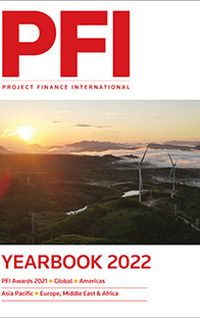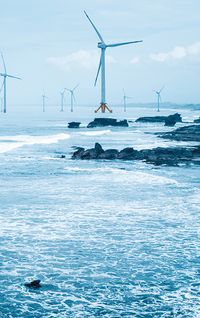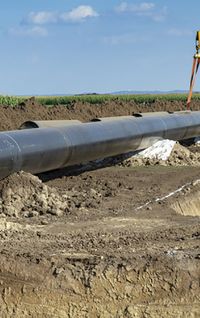The first major offshore wind farm in the United States was financed this year. The deal involved 25 banks and is surely the opening of the PF floodgates for offshore wind. By Nic Stone.
The town of New Bedford on the southern coast of Massachusetts is where Herman Melville’s Moby Dick opens, a bustling nineteenth century whaling city from where Captain Ahab sets out on his whaler Pequod in search of the eponymous white whale.
The town is now home to many delights, including a whaling museum, the Moby Dick Brewing Company for those so inclined – try the Ishmale Irish-style Amber Ale! – and the offices of Vineyard Wind, the company that closed the first major project finance deal backing an offshore wind farm in the United States.
Vineyard Wind – a 50:50 joint venture between Avangrid Renewables, a subsidiary of Avangrid, and Copenhagen Infrastructure Partners (CIP) – closed the multi-billion-dollar financing backing the 800MW Vineyard Wind I project off the coast of Martha’s Vineyard in September this year, in what was the first major deal backing an offshore wind project in the country and will likely kick off a decade of similar whale-sized deals.
The main project finance loan has a nearly ten-year tenor, maturing on April 30 2031. Final sizing was US$2.344bn. There was a standby letter of credit signed for US$104m, maturing in just under three years on April 30 2024. Pricing was Libor plus 137.5bp with commitment fees of 40bp.
The nine banks that led the deal were Santander, BNP Paribas, BBVA, Bank of America, MUFG, Credit Agricole, JP Morgan, Natixis, and NatWest. They then brought more banks in during syndication, namely Apple Bank, Associated Bank, Sabadell, Bank of China, Korea Development Bank (KDB), CaixaBank, KfW, BayernLB, CoBank, Commerzbank, Intesa Sanpaolo, Scotiabank, Norinchukin, Helaba, Shinsei Bank, and Standard Chartered.
Total costs of the project are expected to be about US$4.1bn. The senior debt will cover 56% of the cost and the remaining 44% will be equity. Lead financing counsel was Norton Rose Fulbright. Latham & Watkins advised the lenders.
“We have proven that large-scale offshore wind projects have the support of the financing community,” Avangrid representatives told PFI.
A long time coming
The offshore wind industry in the US has proved to be a bit of a white whale itself; elusive, hard to predict, and for the project finance community, always in the back of your mind. The nature of the breakthrough that this project represents is best seen in the figures that turned up for the groundbreaking for the onshore infrastructure toward the end of 2021.
Secretary of the Interior Deb Haaland joined Massachusetts Governor Charlie Baker and other luminaries to commemorate the start of construction. That governmental support was something that in the end proved the critical turning point in the financing process.
The US has a goal of reaching 30GW of offshore wind by 2030. That goal emerged in the early stages of the Biden-Harris partnership and has become almost a rallying cry for the industry. With essentially no offshore wind feeding the grid now, the goal is also rather lofty.
When development costs are taken into account, there will be a need for upwards of US$50bn in capital backing the build-out in the coming years – similar to the amount raised in the past decade backing the proliferation of liquefied natural gas (LNG) export facilities across the US.
For Vineyard Wind, the financing process began in 2019, but really kicked into gear once regulatory approvals under the current administration looked likely to be prioritised in early 2021, Avangrid says. Santander was mandated as financial adviser and advised the sponsors closely on the structuring and execution of the transaction.
The administration through the Bureau of Ocean Energy Management (BOEM) approved Vineyard in May 2021. The project began its federal permitting process more than three years before that and endured a string of delays in part due to concerns that the wind turbines would interfere with commercial fishing. With approvals in, the financing conversations got real.
“We began the process in 2019 with probably 60 institutions and private investors,” Avangrid told PFI. “We narrowed down to a group of nine banks. The project had to be put on hold for a period while the federal government deliberated about whether to issue construction permits for any offshore wind projects off the Atlantic coast.
“We came back in 2021 with the same bank group. PF banks were supportive of this project throughout the permitting process, even with its challenges. Banks reached out to us saying, ‘We are ready to restart when you are'.”
Project finance was always the preferred option for financing for the company, it said, given that Vineyard Wind 1 is a JV of sponsors with different business profiles, despite the team exploring other options.
“We were looking for a type of financing that made sense to both sponsors at competitive conditions and project finance addressed those requirements,” Avangrid said.
Of course, Vineyard may have been the first major PF deal, but it owes a lot to many others. Also in Massachusetts, industry veteran Jim Gordon spent many years with the dream of developing the Cape Wind offshore wind farm off Cape Cod and in many ways paved the way for what was possible in the US project finance market when he showed banks were keen on the sector.
In 2014, MUFG, Rabobank, and Natixis launched syndication on roughly US$1bn in bank debt to back the 454MW Cape Wind project. The project had a conditional commitment for a US$150m loan guarantee from the US Department of Energy (DOE), a US$600m loan from Danish export credit agency EKF, and US$200m in mezzanine debt from Pension Denmark.
Cape Wind never materialised after a series of regulatory challenges and setbacks led to cancelled contracts and ultimately no project. US project finance banks, despite being told of the deals they could expect from European counterparts, were then slower to warm to the idea of offshore wind, due in part to high costs, very long development lead times, and the supply of easier, quicker transactions in the solar and onshore wind renewables space. Those things, combined with the high-profile failure of the Cape Wind project to close financing at the end of 2014, led to a lukewarm reception from the financial community for new schemes in the ensuing years.
Even when in 2015 Deepwater Wind Block Island reached financial close on more than US$290m in project financing provided through Societe Generale and KeyBank backing the 30MW Block Island offshore wind farm off the coast of Rhode Island, the first project finance deal in the US backing an offshore wind project, it was seen as a bit of a standalone deal for a project of a small scale.
That deal was broken down into a US$268.1m term loan and US$28.4m standby letter of credit. The deal was priced at Libor plus 200bp. In October 2016, GE Energy Financial Services and Citi added tax equity financing to the project. But once the regulatory support kicked in, the project finance community was ready and waiting to commit.
Structure of the deal
The deal is a mini-perm financing of a construction loan followed by a term loan for several years post-COD. The deal has very similar covenants to what is being negotiated in onshore deals, according to sources.
“The debt size and loan amortisation were based on the PPA length, plus a few years of merchant revenue,” Avangrid said. “We were very pleased with the pricing and feel it is a strong endorsement of our project, its sponsors, and the US offshore industry.”
Vineyard Wind signed two PPAs with Massachusetts electric distribution companies in July 2018 for a combined 800MW, with reports saying the pricing is around the US$98/MWh mark when everything is taken into account, including tax credits.
The PF deal was agreed in September and the lead banks had hoped to close syndication of the sizeable debt package by the end of October, said sources, a process that got pushed into December. There is still work to be done, even after that is finished.
“We do plan on a tax equity deal for Vineyard Wind 1 and have the possibility to raise an associated bridge loan,” Avangrid said. “Once construction is done, the mini-perm loan will convert into a term loan with already negotiated conditions, once we have achieved standard conditions precedent for the conversion.”
Refinancing at the end of the mini-perm is still quite far away, but that is something the companies involved have already thought through. There is also a situation where tax equity won’t be needed, Avangrid said.
“With Build Back Better, there is the possibility that direct pay will be available to monetise the project’s tax credits. In the event this becomes available, we will analyse its impact on the project’s cashflows and economics as an alternative to tax equity financing.”
The first of many
The lofty goals set by the administration and the vast pipeline of projects being submitted for regulatory approval at BOEM mean Vineyard is likely to be the first of many deals in the sector over the coming years.
It is expected that project finance will continue to play an important role in the build-out. “Reaching FC and managing it requires a lot of resources but limits the sponsor’s risk. If the final terms and conditions are competitive, project finance can be an excellent form of financing for offshore wind,” Avangrid said.
Avangrid has another offshore project with a PPA, the 804MW Park City Wind, and two more offshore projects under development, the 1.2GW Commonwealth Wind and Kitty Hawk projects, which saw construction and operations plans submitted in December.
“All possibilities to finance offshore growth are on the table at the moment, including project finance,” Avangrid told PFI. “We would like to see the same level of interest and liquidity for the next deals to come to market so the industry is able to escalate and reach the 30GW by 2030 goal of the current administration.”
Shortly after closing the project finance deal, Vineyard Wind agreed to restructure its US offshore wind joint venture by swapping ownership of jointly owned assets, effectively ending the JV working together on near-future developments. CIP will become the 100% owner of federal lease area OCS-A 522, which can accommodate up to 2.5GW of offshore wind, while Avangrid will become the owner of OCS-A 534, containing the Park City Wind project and the Commonwealth Wind project.
The Vineyard Wind I project will feature 62 13MW General Electric Haliade-X wind turbines that will be connected to an offshore substation, where the power will be transferred to two export cables that will make landfall at Covell’s Beach and connect to the grid at an inland substation. It will begin delivering clean energy to Massachusetts in 2023.
To see the digital version of this report, please click here
To purchase printed copies or a PDF of this report, please email gloria.balbastro@lseg.com

















